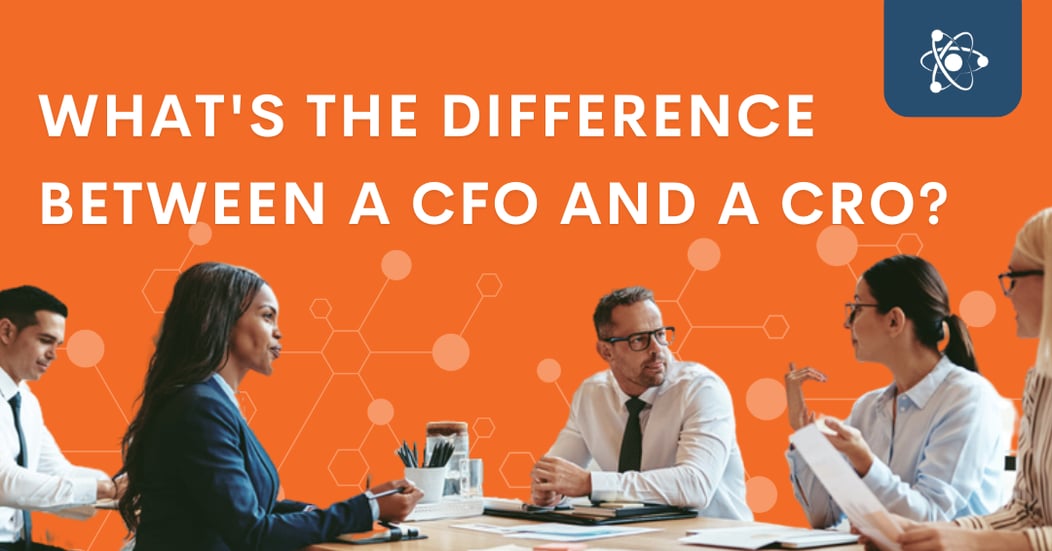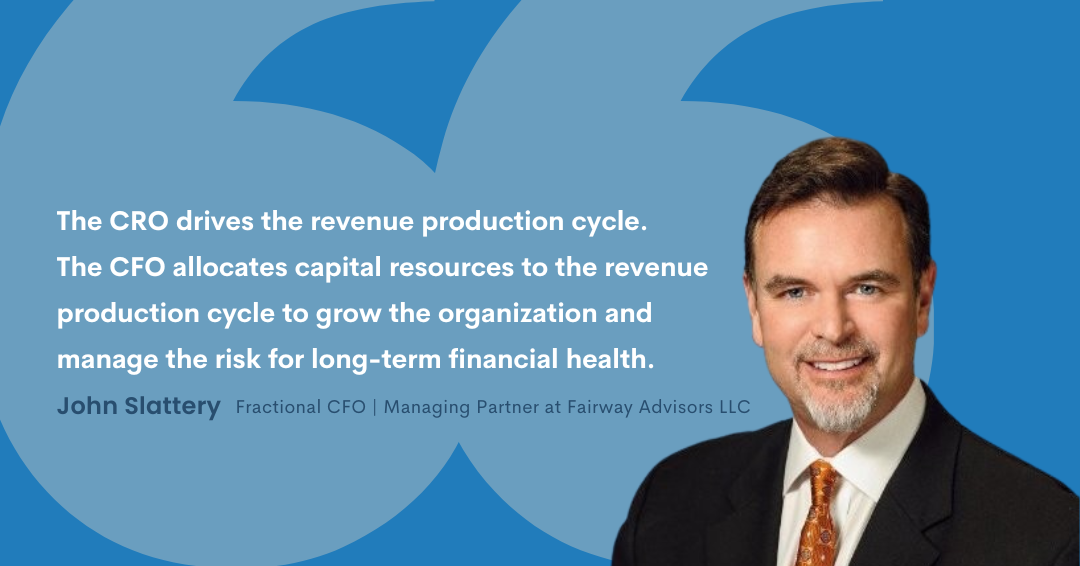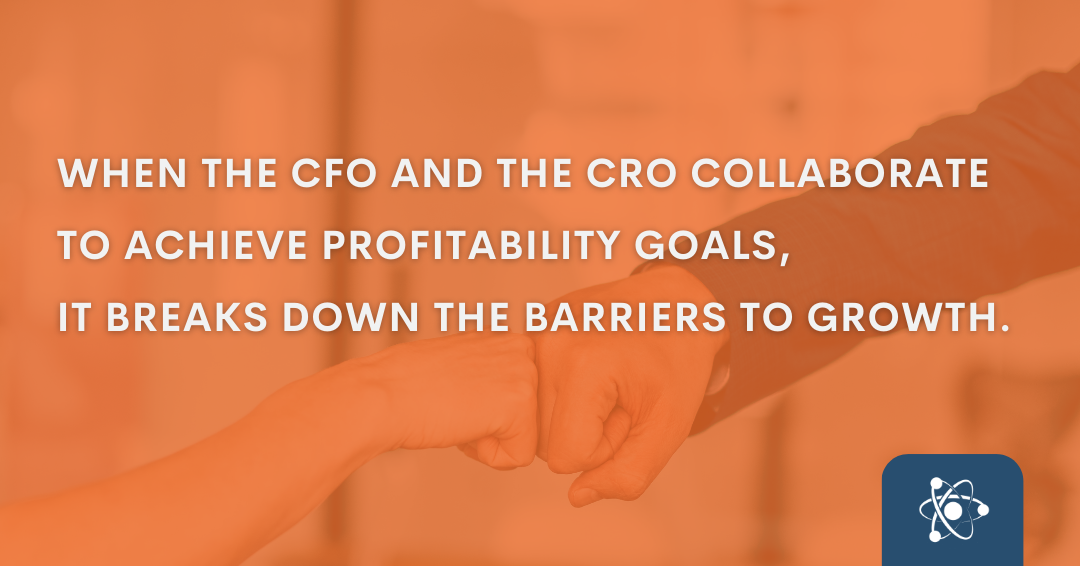
As a business owner or a C-suite executive, you understand the importance of different officers and their roles at your B2B company. CEOs, COOs, and CFOs have been around for a long time with straightforward and well-known responsibilities. However, one of the newer kids on the block is the Chief Revenue Officer (CRO).
Since the Atomic Revenue team is asked quite often, “What does a CRO do, and what are the differences between a CFO and a CRO?” we thought we would ask a couple of experts, Andrea Edmonds, a COO, CFO, and fractional revenue leader, and John Slattery, Chief Executive and Financial Officer with extensive cross-functional experience, to help us clarify and expand on each role.
In this blog, we answer:
- What's the difference between a CFO and CRO and what does each person do within the company?
- How often does the CFO collaborate with the CRO to reach profitability goals?
- What metrics does a CFO versus a CRO focus on?
- How does technology play a role in each officer’s functionality?
- Does your company need to expand its leadership team or fill out its EOS accountability chart?
What’s the Biggest Difference Between a CFO & CRO?
The biggest difference between a chief financial officer and a chief revenue officer is that a CFO is responsible for creating and upholding financial strategies, management, functions, and accounting across the entire organization, whereas a CRO is responsible for data-driven revenue operations and profitability through customer advocacy.
Both roles put the company’s profitability at the heart of what they do just in different ways. John Slattery, Managing Partner at Fairway Advisors LLC and fractional CFO, says, “The two parties have to work together on pricing and cost models if they are going to drive profitability.”
A CRO should be skilled in the art of getting all departments to work toward the same goals and create a scalable revenue system to sustain predictable and profitable revenue streams for the organization.
The Chief Financial Officer (CFO) Role: What Exactly Does a CFO Do?
Andrea Edmonds, COO at Overwatch Digital Health and an Atomic Revenue fractional revenue leader, says, “The Chief Financial Officer is an important partner to the CEO and is responsible for stewarding the organization across all company functions. A CFO actively manages growth and risk including legal, financial, and regulatory risks. This person works with functional areas of the company to either invest more capital when they are generating great returns or try to pivot when they are not achieving the desired returns.”
A CFO also:
- Assists the CEO in hiring capable functional leaders to achieve future growth targets.
- Owns the annual budget and the 5-year strategic plan and measures the achievement of functions based on growth targets and spend.
- Plays a key role in mergers and acquisitions to evaluate if there are other players in the market that would be synergistic to the organization's customers and/or move the company ahead on its roadmap and time to market.
- Along with the CEO, takes an important leadership role with the Board of Directors to communicate company results and strategies.
The Chief Revenue Officer (CRO) Role: What Does a CRO Do?
The role of Chief Revenue Officer began in Silicon Valley around 2010 to make the most of selling new digital products/services opportunities. Jump ahead to 2023 and you’ll find the CRO cares for 130 elements of end-to-end revenue operations, which includes everything and everyone who is part of the revenue production process with the goal of increasing profitability through customer advocacy.
This person is not the marketing manager or the sale manager, he or she oversees those departments as an integrator who establishes data-driven revenue strategies, develops inter-departmental and inter-personal collaboration, and creates a scalable revenue system that ensures the 7-stage customer journey is met.
The CRO also:
- Creates the revenue plan and hires key players across marketing, sales, and customer success to execute the plan and achieve the desired revenue targets together, without departmental silos and with accountability.
- Collects and utilizes the right data and metrics to ensure the dashboard and KPIs by which the company makes decisions are meaningful.
- Creates a scalable revenue system that sustains predictable and profitable revenue streams for the organization.
- Collaborates with everyone in the company who is part of the customer journey, from the warehouse and shipping people to sales and marketing to customer service teams, finance, and HR, as well as those in the boardroom, to ensure everyone is working toward the same goal: customer advocacy.
.png?width=1200&height=628&name=Atomic%20Revenue%20Blog%20Headers%20and%20Graphics%20(69).png)
How Often Does a CFO Collaborate with the CRO to Reach Profitability Goals?
Edmonds explains, “Depending on the maturity of the company, the sales forecast reviews will vary. Generally, there is an annual planning cycle where the strategic 1-year, 3-year, and 5-year plans are created and agreed upon. In addition to the annual planning cycle, there are weekly or monthly check-ins to make sure the current sales forecast is on track with what was previously committed by the CRO. Transparency between the CRO and CFO regarding material changes in the sales forecast is critical.”
The CRO and the CFO will also collaborate on new monetization strategies with upcoming products/services features and functionality. When the CRO manages revenue operations using meaningful metrics that drive good decision-making, targets can be met, and collaboration is that much better.

What Metrics Does a CFO vs. CRO Focus On?
Data is at the heart of all good planning. Without meaningful benchmarks and metrics to measure outcomes and make decisions, you can’t achieve long-term profitability. “Data-driven management is imperative. Where the data comes from isn’t as important as whether it is accurate along with ease of accessibility,” says Slattery.
He adds, “CFOs are more oriented on gross profit and collection KPIs, such as DSO and net income percentages of revenues. We do have complementary KPIs with the CRO, including backlog, bookings, and other CRM analytics that can predict revenues and results.”
So which metrics does a CFO use to make decisions versus a CRO?
CFO Metrics & Data
CFO metrics and data are tied to overall company financial goals, including receivables, gross profit, and collection KPIs such as days outstanding sales (DSO) and net income percentages of revenues.
- Earnings before Income Taxes and Depreciation (EBITDA)
- Customer Acquisition Costs (CAC)
- Lifetime Value of Customer (LTV)
- LTV/CAC Ratio
- Cash Burn Rate
- Days Sales Outstanding (DSO)
- Accounts Receivable Aging
- Accounts Payable Aging
- Gross Margin Total – Gross Margin by Business Line
- Revenue per Employee/Bookings per Employee
- Budget/Plan to Actual (Monthly, Quarterly, Annual)
- Deferred Revenue
- Churn
- Net Dollar Revenue Retention
- Bookings by New Logo, Renewals, Upsells vs. Forecasted
- Annual Contract Value (ACV)
CRO Metrics & Data
The bulk of the CRO’s role is tied to multiple revenue-based KPIs, such as Marketing Qualified Leads (MQLs), Sales Qualified Leads (SQLs), and Customer Acquisition Costs (CACs), knowing who’s responsible for them, where the data is coming from, and what lever needs to be pulled to affect the numbers in a desirable way.
- Sales Qualified Leads (SQLs)
- Marketing Qualified Leads (MQLs)
- Market segmentation
- Customer segmentation
- Leads converted into qualified sales prospects by channel/direct
- Leads generated channel/direct: which channel is working to attract leads (events, social media, digital marketing, website, outbound calling …).
- Average sales cycle per product channel/direct
- Average sales price by channel/direct
- New sales, repeat sales, upsells, referrals
- Win Rate & Reasons
- Loss Rate & Reasons
- Bookings by New Logo, Renewals, Upsells/Account Expansion
- Gross Margins
- Churn
- Net Dollar Revenue Retention
- Customer Acquisition Costs (CAC)
- Lifetime Value of Customer (LTV)
- LTV/CAC
- Net Promoter Score
- Website visitors/conversions by channel (how are we attracting/converting customers?)
- Open rates via email for outbound campaigns
.png?width=1200&height=629&name=Atomic%20Revenue%20Blog%20Headers%20and%20Graphics%20(73).png)
Technology is Critical in Both Roles, But Especially So for the CRO
Technology plays an important role in scaling companies. However, technology alone cannot scale organizations without proper alignment between people and functions and the establishment of data-driven processes. There are a lot of great tools out there and their cost and time to implement have been reduced because of the SaaS cloud market.
CRO Technology & Tools
“The CRO must have a clear tech stack for the revenue operations process to succeed. To do this, automation must help attract and nurture leads, qualify them, convert them into sales prospects, close the sale, and manage and support customers throughout the 7-stage buyer’s journey, including onboarding, problem-solving, special projects, expansion, NPS measurement, and more,” says Edmonds.
There are many sales tools that can augment the revenue production process including customer relationship management (CRM) software, conversational intelligence, and prospecting, but the technology must have well-defined processes and the CRO’s people need to successfully adopt it and be dedicated to managing the data to provide value to the company. Without adoption and management, technology is just an expense.
CFO Technology & Tools
“Since the CFO is the financial steward for the company, this person is responsible for executing a disciplined procurement process and driving the function to perform due diligence to make certain the company will get value from the technology and that it is within budget,” says Edmonds.
“The chief financial officer evaluates and uses the best technology for the maturity of the company and what the company will need to expand to the five-year projection. There are lots of decisions to be made in terms of system capabilities and the process requirements in terms of US GAAP, inventory, bill of materials, billing, currency, and taxes,” she adds.
Why is There Conflict Between the CRO and CFO?
A CFO and CRO each play a very different role in the organization, but they are both needed for the organization to succeed, though at times there may be a conflict between the roles. They fundamentally have different objectives and views of the organization.
One example of CFO/CRO friction is when the CRO wants to spend money to make money and the CFO wants to cut back because the ROI is not there. This conflict is healthy and provides a checks-and-balances system for the long-term health of the organization. Both perspectives are valuable and should be discussed openly between the two so there is transparent decision-making and they can reach a mutual data-based decision.

Does Your Company Need a CFO and a CRO?
Does your company need a CFO and a CRO? Absolutely! As described above, the roles execute very different strategic objectives. While they are complementary, the CRO is revenue operations focused — lead generation, sales conversion, and customer advocacy driven — whereas the CFO is financially driven and focuses accounting, EBITDA, and overall risk and reward for the entire organization.
Some executives scoff at the role of CRO as they feel it is not necessary. However, as technology and the sales cycle have integrated and there is a lot of “noise” to fight through to get your message heard, there needs to be a person who focuses on aligning your people, process, technology, and data to the 130 elements of revenue operations to make customer advocacy possible. Without customer advocacy, the CFO will be tightening the financial strings as profitability stagnates, or worse, declines.
What if Your Company Doesn’t Have the Budget for a Full-Time CFO or CRO?
Many companies have let go of a number of salaried employees and C-suite executives, while some have never had a full-time CFO or CRO because the budget doesn’t allow for it, or they feel they are too small to warrant it. This is where a fractional CFO or CRO is highly beneficial.
A fractional executive takes on an interim role for a “fraction” of the time, cost, and commitment of a salaried employee. This consultant is a cross-functional executive or manager who can fill whatever role you need– CFO, COO, CMO, CTO, sales manager, or marketing manager – and provide an outside perspective on goal achievement to meet your defined objectives and help your company achieve profitability. A fractional leader can also fill important leadership roles while your business scales.
Fractional management ROI includes improved productivity, increased profitability, consistent interdepartmental collaboration, and enhanced professional development, which are investments that continue to yield dividends beyond the term of a contractor agreement.
A fractional revenue leader is also a way to fill in your EOS® accountability chart to gain Traction®. Atomic Revenue runs on EOS, we speak the language and offer fractional leadership to assist other companies that run on EOS, and as part of our overall revenue operations solutions.

Understanding the Difference Between a Chief Financial Officer & Chief Revenue Officer will Guide Your Revenue Operations Objectives with More Clarity
A CRO aligns your people, process, technology, and data to the revenue operations process in order to achieve customer advocacy. He or she, in collaboration with the CFO, will use data-driven information to improve upon, eliminate, or adjust budget allocations to desired profitability outcomes.
When the CFO, who is responsible for the overarching financial health of the company, and the CRO work together to achieve certain goals, it breaks down the barriers to growth. And one thing is for sure — if you want to improve profitability, a CRO and a CFO on your team are a must-have duo.
Atomic Revenue is Here to Help Your Company with Fractional CRO, CFO, or C-suite Executive Services
If you are interested in learning more or would like to discuss fractional executive solutions for your B2B company, don’t hesitate to set up a free conversation with one of our fractional executives. Because Atomic Revenue runs on EOS®, we speak the language and understand the importance of getting the right people in the right seats. Schedule a call today and let’s see where it leads.
 About the Author
About the Author
Lauren Fast is the Brand & Exposure Manager for Atomic Revenue and co-owner of Fast Bryant Consulting. Her specialty is managing and implementing content development while creating clients’ brand strategies. Lauren has a proven history of developing successful public-facing content and brand-building that fosters lead generation, sales conversion, and customer advocacy. She also has comprehensive social media, website, public speaking, coaching, and content marketing experience and a proven record as a top-performing Senior Sales Director and trainer.

.jpg)



